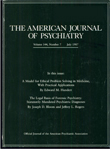Rapid Mood Swings After Unmonitored Light Exposure
Ms. A was a 38-year-old woman who suddenly developed alarming mood swings that ranged from feelings of total excitement to those of deep depression with severe suicidal ideation. These extremes sometimes alternated within the hour and occurred three to four times a day. This crisis had been preceded by a 7-day period in which she had been experimenting at home with light equipment (10,000 lux) that she had purchased herself. The frequency and duration of use and the distance between her eyes and the equipment were very different from our normal guidelines. Two days after the mood swings started, her sleep shortened to 3 hours a night. Before that, she had been sleeping 7 hours a night while taking 10 mg of diazepam for treatment of whiplash injury. Her sleep had been interrupted previously because of bronchitis.
One year earlier, Ms. A had been diagnosed as having a recurrent brief depression with a seasonal pattern (winter type) (1). Twice during the previous winter she had been treated successfully in our clinic with light therapy (30 minutes at 10,000 lux for 5 days). When depressive symptoms first appeared this winter, she was unable to visit our clinic because she had been in a car accident. She exposed herself more intensively to light because she perceived it to have energizing and mood-elevating effects. She recognized certain addictive behavior characteristics in the way that she used the light because up until 10 years ago, she had had a long period of alcohol addiction.
We urged Ms. A to stop light therapy immediately and started treatment with risperidone and benzodiazepines at night. This unusual regimen was given since Ms. A objected to proposed standard medications because of a fear of side effects. The mood swings disappeared after a couple of days, and Ms. A developed a more stable euphoric mood instead, with concomitant hyperactivity; short sleep continued. It took 2 months until the manic episode was in complete remission and medication could be stopped. At the beginning of the next month, the depressive symptoms reappeared. These symptoms were treated successfully with our usual light therapy regimen.
References
Information & Authors
Information
Published In
History
Authors
Metrics & Citations
Metrics
Citations
Export Citations
If you have the appropriate software installed, you can download article citation data to the citation manager of your choice. Simply select your manager software from the list below and click Download.
For more information or tips please see 'Downloading to a citation manager' in the Help menu.
View Options
View options
PDF/EPUB
View PDF/EPUBGet Access
Login options
Already a subscriber? Access your subscription through your login credentials or your institution for full access to this article.
Personal login Institutional Login Open Athens loginNot a subscriber?
PsychiatryOnline subscription options offer access to the DSM-5-TR® library, books, journals, CME, and patient resources. This all-in-one virtual library provides psychiatrists and mental health professionals with key resources for diagnosis, treatment, research, and professional development.
Need more help? PsychiatryOnline Customer Service may be reached by emailing [email protected] or by calling 800-368-5777 (in the U.S.) or 703-907-7322 (outside the U.S.).

